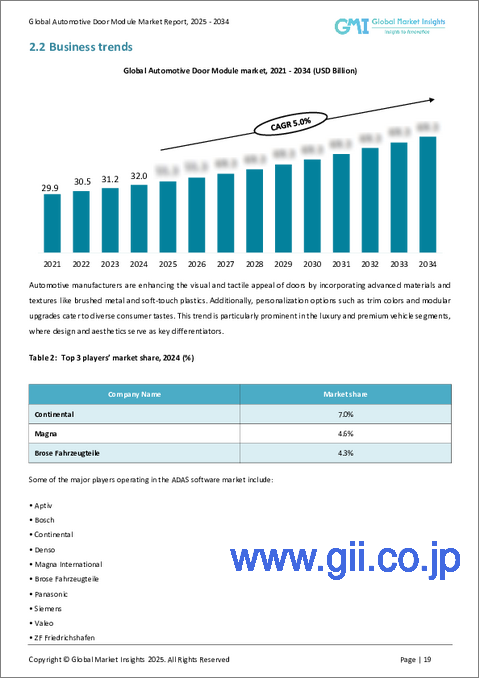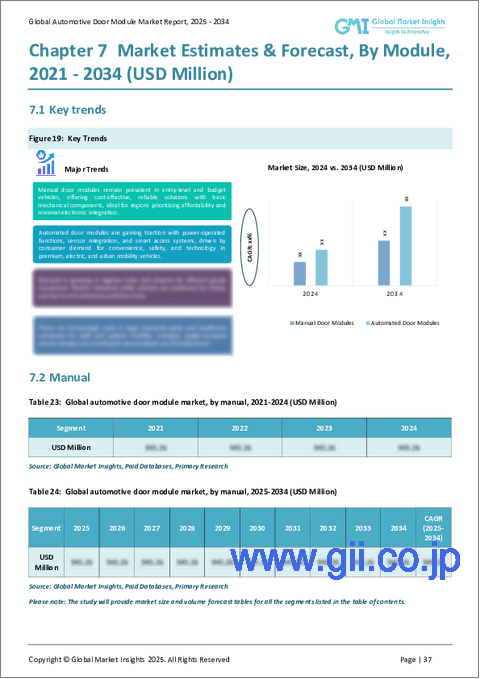|
|
市場調査レポート
商品コード
1639306
自動車用ドアモジュール市場の機会、成長促進要因、産業動向分析、2025年~2034年の予測Automotive Door Module Market Opportunity, Growth Drivers, Industry Trend Analysis, and Forecast 2025 to 2034 |
||||||
カスタマイズ可能
|
|||||||
| 自動車用ドアモジュール市場の機会、成長促進要因、産業動向分析、2025年~2034年の予測 |
|
出版日: 2024年11月26日
発行: Global Market Insights Inc.
ページ情報: 英文 180 Pages
納期: 2~3営業日
|
全表示
- 概要
- 目次
2024年の自動車用ドアモジュールの世界市場規模は320億米ドルで、2025年から2034年にかけてCAGR 5%で成長すると予測されています。
電気自動車と自律走行車(EVとAV)の採用が増加していることは、これらの自動車が最先端の機能、軽量部品、効率性を重視していることから、大きな成長促進要因となっています。複合材料やアルミニウムなどの軽量材料は、バッテリーの性能を最適化し走行距離を延ばすために、特にEVのドアモジュールに不可欠となっています。
自律走行車は、安全性と利便性を最優先するインテリジェント・ドア・システムの需要に拍車をかけています。自動ロック、近接センサー、障害物検知などの機能がドアモジュールに統合されるケースが増えています。さらに、多くのEVやAVのプレミアムな位置づけが、カスタマイズ可能なモジュール式ドア設計の革新を促し、市場拡大をさらに後押ししています。
市場は車両タイプ別に乗用車と商用車に区分されます。2024年には乗用車が75%のシェアを占め、2034年までに350億米ドルを創出すると予測されます。生産台数の多さと、セダン、SUV、クロスオーバーといった多用途で手頃な価格の車両に対する消費者の嗜好が主な要因です。中国やインドを含む新興国は、中間層が急速に拡大し、自動車需要が伸びているため、主要な貢献国となっています。
| 市場範囲 | |
|---|---|
| 開始年 | 2024 |
| 予測年 | 2025-2034 |
| 開始金額 | 320億米ドル |
| 予測金額 | 486億米ドル |
| CAGR | 5% |
モジュールタイプ別では、市場は手動ドアモジュールと自動ドアモジュールに分けられます。自動ドアモジュールは、高度な機能に対する消費者の需要の高まりにより、2024年の市場シェアの67%を占めました。これらのシステムには、パワーウィンドウ、集中ロック、挟み込み防止センサー、電子制御などが含まれ、よりスマートで安全な自動車へのニーズに対応しています。
アジア太平洋地域の自動車用ドアモジュール市場は、2024年には40%のシェアを占め、2034年には215億米ドルを生み出すと予想されています。中国は極めて重要な役割を果たしており、その市場は2034年までに95億米ドルを生み出すと予測されています。自動車生産、特にEVの世界的リーダーとして、主要な相手先商標製品メーカー(OEM)に支えられた中国の強固な自動車製造エコシステムが、この地域の成長を引き続き牽引しています。
目次
第1章 調査手法と調査範囲
第2章 エグゼクティブサマリー
第3章 業界洞察
- エコシステム分析
- サプライヤーの状況
- ティア1サプライヤー
- 部品サプライヤー
- 半導体メーカー
- 原材料サプライヤー
- 自動車メーカー
- 利益率分析
- コスト内訳分析
- テクノロジー&イノベーション・情勢
- 主要ニュースと取り組み
- 規制状況
- 影響要因
- 促進要因
- 電気自動車と自律走行車の成長
- 高度な車両機能に対する需要の高まり
- 車両の美観とパーソナライゼーションへの注目の高まり
- 燃費向上のための車両軽量化への注目
- 業界の潜在的リスク&課題
- 高い製造コスト
- 車両システムとの複雑な統合
- 促進要因
- 成長可能性分析
- ポーター分析
- PESTEL分析
第4章 競合情勢
- イントロダクション
- 企業シェア分析
- 競合のポジショニング・マトリックス
- 戦略展望マトリックス
第5章 市場推計・予測:コンポーネント別、2021年~2034年
- 主要動向
- ラッチ&ハンドル
- ウィンドウレギュレーター
- スピーカー
- モーター&アクチュエーター
- 電気コネクター&配線
- コントロールユニット
- シーリングシステム
- その他
第6章 市場推計・予測:車両別、2021年~2034年
- 主要動向
- 乗用車
- ハッチバック
- セダン
- SUV・クロスオーバー
- 商用車
- 小型商用車(LCV)
- 大型商用車(HCV)
第7章 市場推計・予測:モジュール別、2021年~2034年
- 主要動向
- 手動
- 自動化
第8章 市場推計・予測:ドア別、2021~2034年
- 主要動向
- フロントドア
- リアドア
- スライドドア
- リフトゲートドア
第9章 市場推計・予測:販売チャネル別、2021年~2034年
- 主要動向
- OEM
- アフターマーケット
第10章 市場推計・予測:地域別、2021年~2034年
- 主要動向
- 北米
- 米国
- カナダ
- 欧州
- 英国
- ドイツ
- フランス
- スペイン
- イタリア
- ロシア
- 北欧
- アジア太平洋
- 中国
- インド
- 日本
- 韓国
- ニュージーランド
- 東南アジア
- ラテンアメリカ
- ブラジル
- メキシコ
- アルゼンチン
- 中東・アフリカ
- UAE
- 南アフリカ
- サウジアラビア
第11章 企業プロファイル
- Aisin
- Aptiv
- Brose Fahrzeugteile
- Continental
- Denso
- Grupo Antolin
- Johnson Electric Holdings
- Lear
- Magna
- Mitsuba
- Mitsubishi Electric
- Panasonic
- Robert Bosch
- Siemens
- Sumitomo Electric Industries
- Toyota Boshoku
- Valeo SA
- Visteon
- Yamaha Motor
- ZF Friedrichshafen
The Global Automotive Door Module Market, valued at USD 32 billion in 2024, is set to grow at a CAGR of 5% from 2025 to 2034. The increasing adoption of electric and autonomous vehicles (EVs and AVs) is a significant growth driver, as these vehicles emphasize cutting-edge features, lightweight components, and efficiency. Lightweight materials such as composites and aluminum are becoming essential for door modules, especially in EVs, to optimize battery performance and extend driving range.
Autonomous vehicles are fueling demand for intelligent door systems that prioritize safety and convenience. Features like automatic locking, proximity sensors, and obstacle detection are increasingly being integrated into door modules. Additionally, the premium positioning of many EVs and AVs is driving innovation in customizable and modular door designs, further boosting market expansion.
The market is segmented by vehicle type into passenger and commercial vehicles. Passenger vehicles dominated in 2024, holding a 75% share, and are projected to generate USD 35 billion by 2034. High production volumes and consumer preference for versatile and affordable vehicles like sedans, SUVs, and crossovers are key factors. Emerging economies, including China and India, are major contributors due to a rapidly expanding middle class and growing automotive demand.
| Market Scope | |
|---|---|
| Start Year | 2024 |
| Forecast Year | 2025-2034 |
| Start Value | $32 Billion |
| Forecast Value | $48.6 Billion |
| CAGR | 5% |
By module type, the market is divided into manual and automated door modules. Automated door modules accounted for 67% of the market share in 2024, driven by rising consumer demand for advanced features. These systems include power windows, centralized locking, anti-pinch sensors, and electronic controls, catering to the need for smarter and safer vehicles.
Asia Pacific automotive door module market held a 40% share in 2024 and is expected to generate USD 21.5 billion by 2034. China plays a pivotal role, with its market projected to generate USD 9.5 billion by 2034. As a global leader in vehicle production, particularly EVs, China's robust automotive manufacturing ecosystem, backed by key original equipment manufacturers (OEMs), continues to drive growth in the region.
Table of Contents
Chapter 1 Methodology & Scope
- 1.1 Research design
- 1.1.1 Research approach
- 1.1.2 Data collection methods
- 1.2 Base estimates and calculations
- 1.2.1 Base year calculation
- 1.2.2 Key trends for market estimates
- 1.3 Forecast model
- 1.4 Primary research & validation
- 1.4.1 Primary sources
- 1.4.2 Data mining sources
- 1.5 Market definitions
Chapter 2 Executive Summary
- 2.1 Industry 360° synopsis, 2021 - 2034
Chapter 3 Industry Insights
- 3.1 Industry ecosystem analysis
- 3.2 Supplier landscape
- 3.2.1 Tier 1 suppliers
- 3.2.2 Component suppliers
- 3.2.3 Semiconductor manufacturers
- 3.2.4 Raw material suppliers
- 3.2.5 Automotive manufacturers
- 3.3 Profit margin analysis
- 3.4 Cost breakdown analysis
- 3.5 Technology & innovation landscape
- 3.6 Key news & initiatives
- 3.7 Regulatory landscape
- 3.8 Impact forces
- 3.8.1 Growth drivers
- 3.8.1.1 Growth of electric and autonomous vehicles
- 3.8.1.2 Rising demand for advanced vehicle features
- 3.8.1.3 Increasing focus on vehicle aesthetics and personalization
- 3.8.1.4 The focus on reducing vehicle weight to improve fuel efficiency
- 3.8.2 Industry pitfalls & challenges
- 3.8.2.1 High manufacturing costs
- 3.8.2.2 Complex integration with vehicle systems
- 3.8.1 Growth drivers
- 3.9 Growth potential analysis
- 3.10 Porter's analysis
- 3.11 PESTEL analysis
Chapter 4 Competitive Landscape, 2024
- 4.1 Introduction
- 4.2 Company market share analysis
- 4.3 Competitive positioning matrix
- 4.4 Strategic outlook matrix
Chapter 5 Market Estimates & Forecast, By Component, 2021 - 2034 ($Bn)
- 5.1 Key trends
- 5.2 Latches & handles
- 5.3 Window regulators
- 5.4 Speakers
- 5.5 Motors & actuators
- 5.6 Electrical connectors & wiring
- 5.7 Control units
- 5.8 Sealing systems
- 5.9 Others
Chapter 6 Market Estimates & Forecast, By Vehicle, 2021 - 2034 ($Bn)
- 6.1 Key trends
- 6.2 Passenger vehicles
- 6.2.1 Hatchbacks
- 6.2.2 Sedans
- 6.2.3 SUVs & crossovers
- 6.3 Commercial vehicles
- 6.3.1 Light Commercial Vehicles (LCV)
- 6.3.2 Heavy Commercial Vehicles (HCV)
Chapter 7 Market Estimates & Forecast, By Module, 2021 - 2034 ($Bn)
- 7.1 Key trends
- 7.2 Manual
- 7.3 Automated
Chapter 8 Market Estimates & Forecast, By Door, 2021 - 2034 ($Bn)
- 8.1 Key trends
- 8.2 Front door
- 8.3 Rear door
- 8.4 Sliding door
- 8.5 Liftgate door
Chapter 9 Market Estimates & Forecast, By Sales Channel, 2021 - 2034 ($Bn)
- 9.1 Key trends
- 9.2 OEM
- 9.3 Aftermarket
Chapter 10 Market Estimates & Forecast, By Region, 2021 - 2034 ($Bn)
- 10.1 Key trends
- 10.2 North America
- 10.2.1 U.S.
- 10.2.2 Canada
- 10.3 Europe
- 10.3.1 UK
- 10.3.2 Germany
- 10.3.3 France
- 10.3.4 Spain
- 10.3.5 Italy
- 10.3.6 Russia
- 10.3.7 Nordics
- 10.4 Asia Pacific
- 10.4.1 China
- 10.4.2 India
- 10.4.3 Japan
- 10.4.4 South Korea
- 10.4.5 ANZ
- 10.4.6 Southeast Asia
- 10.5 Latin America
- 10.5.1 Brazil
- 10.5.2 Mexico
- 10.5.3 Argentina
- 10.6 MEA
- 10.6.1 UAE
- 10.6.2 South Africa
- 10.6.3 Saudi Arabia
Chapter 11 Company Profiles
- 11.1 Aisin
- 11.2 Aptiv
- 11.3 Brose Fahrzeugteile
- 11.4 Continental
- 11.5 Denso
- 11.6 Grupo Antolin
- 11.7 Johnson Electric Holdings
- 11.8 Lear
- 11.9 Magna
- 11.10 Mitsuba
- 11.11 Mitsubishi Electric
- 11.12 Panasonic
- 11.13 Robert Bosch
- 11.14 Siemens
- 11.15 Sumitomo Electric Industries
- 11.16 Toyota Boshoku
- 11.17 Valeo SA
- 11.18 Visteon
- 11.19 Yamaha Motor
- 11.20 ZF Friedrichshafen





